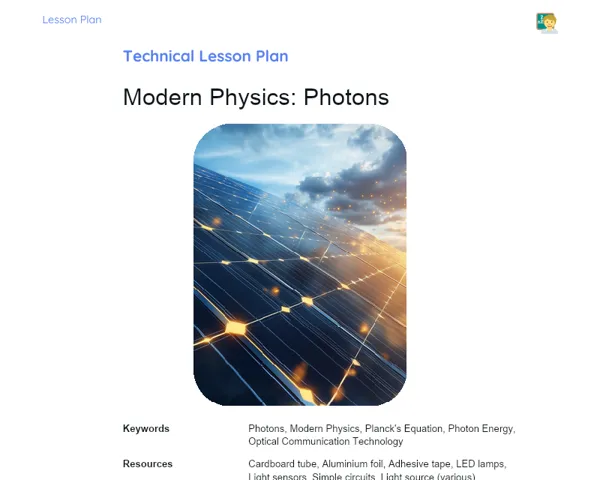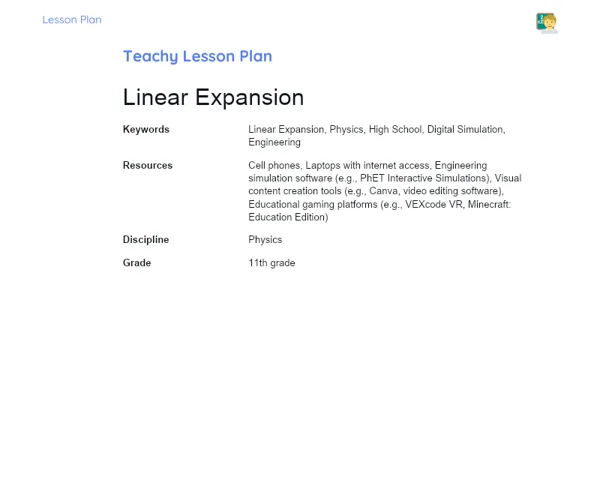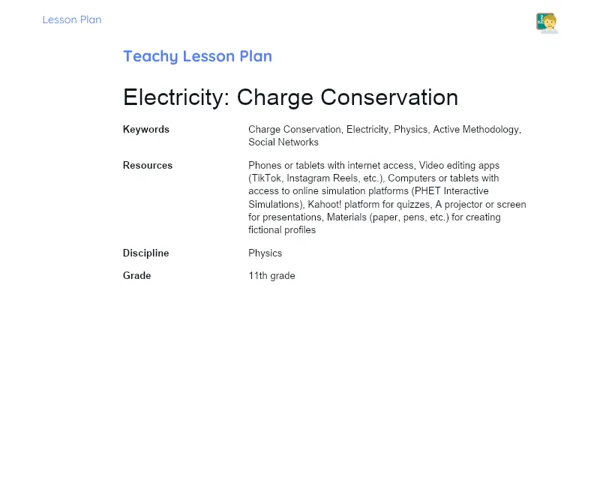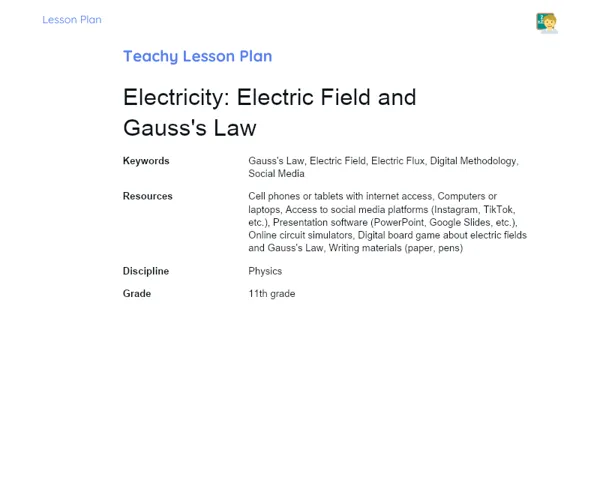Lesson Plan | Lesson Plan Tradisional | Waves: Electromagnetic and Mechanical
| Keywords | Waves, Electromagnetic, Mechanical, Wavelength, Frequency, Amplitude, Speed, Propagation, Energy, Sound Waves, Visible Light, Radio Waves, X-rays, Seismic Waves, Differences and Similarities, Everyday Applications, Theory, Practice, Examples |
| Resources | Whiteboard, Markers, Multimedia projector, Presentation slides, Computer, Internet connection, Notebook, Pens, Printed supporting material (if required) |
Objectives
Duration: 10 to 15 minutes
This stage aims to introduce learners to the concept of waves, laying a strong groundwork for them to grasp the differences between electromagnetic and mechanical waves. It sets them up for the specific content to come, ensuring they have the prerequisite understanding to follow the in-depth explanations later on.
Objectives Utama:
1. Explain the concept of waves and their key characteristics.
2. Distinguish between electromagnetic and mechanical waves using clear, local examples.
Introduction
Duration: 10 to 15 minutes
This stage is meant to lay the groundwork for the concept of waves, prepping learners for the content they will explore. It ensures they have a solid initial understanding before diving into more detailed explanations.
Did you know?
Did you know that radio waves help transmit your favourite songs and news? They’re a type of electromagnetic wave! And the seismic waves we feel during an earthquake? Those are mechanical waves. These examples show just how waves play a role in our daily lives.
Contextualization
Kick off the lesson with an explanation of how wave physics is key to grasping many everyday phenomena. From the sounds we hear to the light we see, waves are all around us. A simple illustration is to drop a stone in a pond, demonstrating how energy spreads out in ripples.
Concepts
Duration: 50 to 60 minutes
This stage aims to deepen learners' understanding of waves, highlighting their characteristics, types, and everyday applications. It’s crucial for students to appreciate the fundamental differences between these wave types and recognize their significance in daily life. Through detailed explanations and relatable examples, learners will consolidate their theoretical understanding and be able to apply these concepts practically.
Relevant Topics
1. Concept of Waves: Describe waves as disturbances that move through a medium or a vacuum, transporting energy without moving matter. Emphasize features like wavelength, frequency, amplitude, and speed.
2. Mechanical Waves: Discuss how mechanical waves need a material medium to travel. Use relatable examples like sound waves and seismic waves, and explain how energy transfers through the medium's particles.
3. Electromagnetic Waves: Explain that electromagnetic waves can move through a vacuum and don’t need a material medium. Give examples such as visible light, radio waves, and X-rays. Highlight how these waves are produced by oscillating electric and magnetic fields.
4. Differences and Similarities: Compare mechanical and electromagnetic waves using a comparative chart for clarity. Address aspects like the medium they propagate through, their speed, and typical examples.
5. Everyday Applications: Illustrate how waves feature in daily life, from radio and TV (electromagnetic waves) to ultrasound used in hospitals (mechanical waves).
To Reinforce Learning
1. What’s the main difference between mechanical and electromagnetic waves in terms of the medium they need to propagate?
2. Can you name a mechanical wave and an electromagnetic wave used in everyday life, and explain how each functions?
3. How do frequency and wavelength of an electromagnetic wave relate to its energy?
Feedback
Duration: 20 to 25 minutes
This stage is designed to help students consolidate what they’ve learned through discussion and the resolution of posed questions. It provides an opportunity for clarification, reinforces concepts, and allows practical application of theoretical knowledge. Additionally, it encourages critical thinking about the content and its relevance in daily life.
Diskusi Concepts
1. What’s the main difference between mechanical and electromagnetic waves regarding the propagation medium? Mechanical waves require a medium like solid, liquid, or gas to travel, transferring energy through particles. For example, sound waves move through air, and seismic waves travel through the earth. In contrast, electromagnetic waves don’t need a medium and can travel through a vacuum, formed by oscillating electric and magnetic fields, such as visible light, radio waves, and X-rays. 2. Can you provide a mechanical wave and an electromagnetic wave from daily life and briefly explain how each operates? An example of a mechanical wave is sound. When someone speaks, their vocal cords generate compressions and rarefactions in the air, which propagate as sound waves to our ears, where we interpret them. An example of an electromagnetic wave is visible light, which travels through air or a vacuum, allowing us to see. 3. How do the frequency and wavelength of an electromagnetic wave relate to its energy? The energy of an electromagnetic wave is directly proportional to its frequency and inversely proportional to its wavelength. This means higher frequency waves (shorter wavelengths) carry more energy. For instance, X-rays have very high frequencies and thus carry a lot of energy, enabling them to penetrate human tissues.
Engaging Students
1. What are some practical uses of mechanical and electromagnetic waves in our lives that weren’t covered in the lesson? Discuss in groups and share your insights. 2. How do you think understanding waves can be beneficial in fields like medicine, communication, and engineering? Provide specific instances. 3. If electromagnetic waves can travel through a vacuum, why do we still use physical means (like wires) to transmit electrical energy? Discuss the pros and cons of this approach. 4. Think of a natural occurrence involving waves. Explain how knowing about waves contributes to understanding this phenomenon. 5. What future developments or technologies could arise from the study of waves? What innovations do you foresee?
Conclusion
Duration: 10 to 15 minutes
This stage aims to sum up and reinforce the key points discussed in the lesson, ensuring students leave with a clear and consolidated understanding. It underscores the topic's practical relevance, connecting theory to application, and emphasizing the importance of the knowledge gained for students' daily lives.
Summary
['Waves are disturbances that propagate through a medium or vacuum, conveying energy without carrying matter.', 'Mechanical waves need a material medium to travel, like sound and seismic waves.', 'Electromagnetic waves don’t require any medium and can travel in a vacuum, like visible light and radio waves.', 'Key distinctions between these wave types involve the medium used and their speeds.', 'Waves play vital roles in daily life, from radio and TV communications to medical ultrasound.']
Connection
The lesson linked theoretical concepts to practical situations by using relatable examples like visible light and radio waves, illustrating the application of wave concepts in everyday life. Furthermore, the detailed explanations and practical examples helped students visualize these phenomena as integral to various technologies we rely on.
Theme Relevance
Understanding waves is crucial for grasping many daily aspects, such as hearing and seeing, and is foundational to developing technologies in medicine, communication, and engineering. For instance, ultrasound in medical examinations and radio played for broadcasts are direct applications of wave knowledge, highlighting their practical importance.



